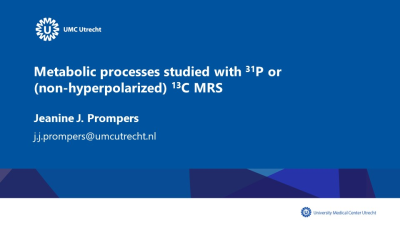Multinuclear Imaging & Spectroscopy: Non-Hyperpolarized Energetics 13C, 31P
Multinuclear Imaging & Spectroscopy: Non-Hyperpolarized Energetics 13C, 31P
Sunrise Session
Sunrise Session
ORGANIZERS: Ronald Ouwerkerk, Wolfgang Bogner
Wednesday, 15 May 2019
| Room 512A-H | 07:00 - 08:00 | Moderators: Rolf Gruetter, Jannie Wijnen |
Skill Level: Basic to Intermediate
Session Number: S-W-05
Overview
This is the third course of a four-part sunrise educational series on multi-nuclear imaging and spectroscopy. Methods for studying metabolism and energetics with 31P and (non-hyperpolarized) 13C imaging and spectroscopy are discussed, covering sampling techniques, hardware, and field dependence. A range of applications for basic science and clinical studies will be used to show how metabolism and energetics can be studied in-vivo by observing 31P or 13C metabolites.
Target Audience
MR physicists and clinicians studying or planning to study metabolism and energetics with 31P and (non-hyperpolarized) 13C imaging and spectroscopy.
Educational Objectives
As a result of attending this course, participants should be able to:
- Recognize the challenges of 31P- and 13C-MRS acquisition;
- Name a number of different 31P- and 13C-MRS acquisition schemes;
- List the pros and cons of various acquisition schemes; and
- Develop an acquisition scheme to suit a specific application.
Overview
This is the third course of a four-part sunrise educational series on multi-nuclear imaging and spectroscopy. Methods for studying metabolism and energetics with 31P and (non-hyperpolarized) 13C imaging and spectroscopy are discussed, covering sampling techniques, hardware, and field dependence. A range of applications for basic science and clinical studies will be used to show how metabolism and energetics can be studied in-vivo by observing 31P or 13C metabolites.
Target Audience
MR physicists and clinicians studying or planning to study metabolism and energetics with 31P and (non-hyperpolarized) 13C imaging and spectroscopy.
Educational Objectives
As a result of attending this course, participants should be able to:
- Recognize the challenges of 31P- and 13C-MRS acquisition;
- Name a number of different 31P- and 13C-MRS acquisition schemes;
- List the pros and cons of various acquisition schemes; and
- Develop an acquisition scheme to suit a specific application.
| 07:00 |
How to Use 31P & 13C MR to Probe Metabolism
Martin Meyerspeer
This educational course covers the technical challenges and solutions related to non-proton MR, focusing on the nuclei 31P and 13C. Topics are dedicated RF hardware (particularly multiply tuned RF coils), pulse sequences and quantification methods, as well as methods and devices for stimulation of the organ under investigation.
The challenges arising with 31P and 13C MRS and MRI are due to the lower resonance frequency and sensitivity (intrinsic NMR sensitivity as well as metabolite concentration and/or natural abundance) and higher chemical shift between resonances, as compared with 1H.Relaxation times and their B0 dependence have to be considered for choosing an appropriate acquisition scheme and its parameters, as well as homo-nuclear and heteronuclear coupling of resonances. The reward for overcoming these hurdles is a non-invasive view on metabolism and its kinetics, hard or impossible to be obtained in any other way. |
|
| 07:30 |
 |
Metabolic Processes Studied with 31P or 13C MRS
Jeanine Prompers
31P and (non-hyperpolarized) 13C MRS are established and often the only non-invasive techniques to measure metabolic pathways in vivo. 31P MRS provides information on energy metabolism and membrane turnover. At natural abundance, 13C MRS can be used to measure tissue glycogen storage. The use of 13C-enriched precursors provides the opportunity to determine fluxes through the TCA cycle and other pathways through dynamic 13C MRS measurements. 31P and 13C MRS can be applied to virtually any organ/tissue. In this educational, examples of applications in skeletal muscle, heart, brain, liver and tumors will be shown.
|
| 08:00 |
Adjournment |
 Back to Program-at-a-Glance |
Back to Program-at-a-Glance |  Back to Top
Back to Top